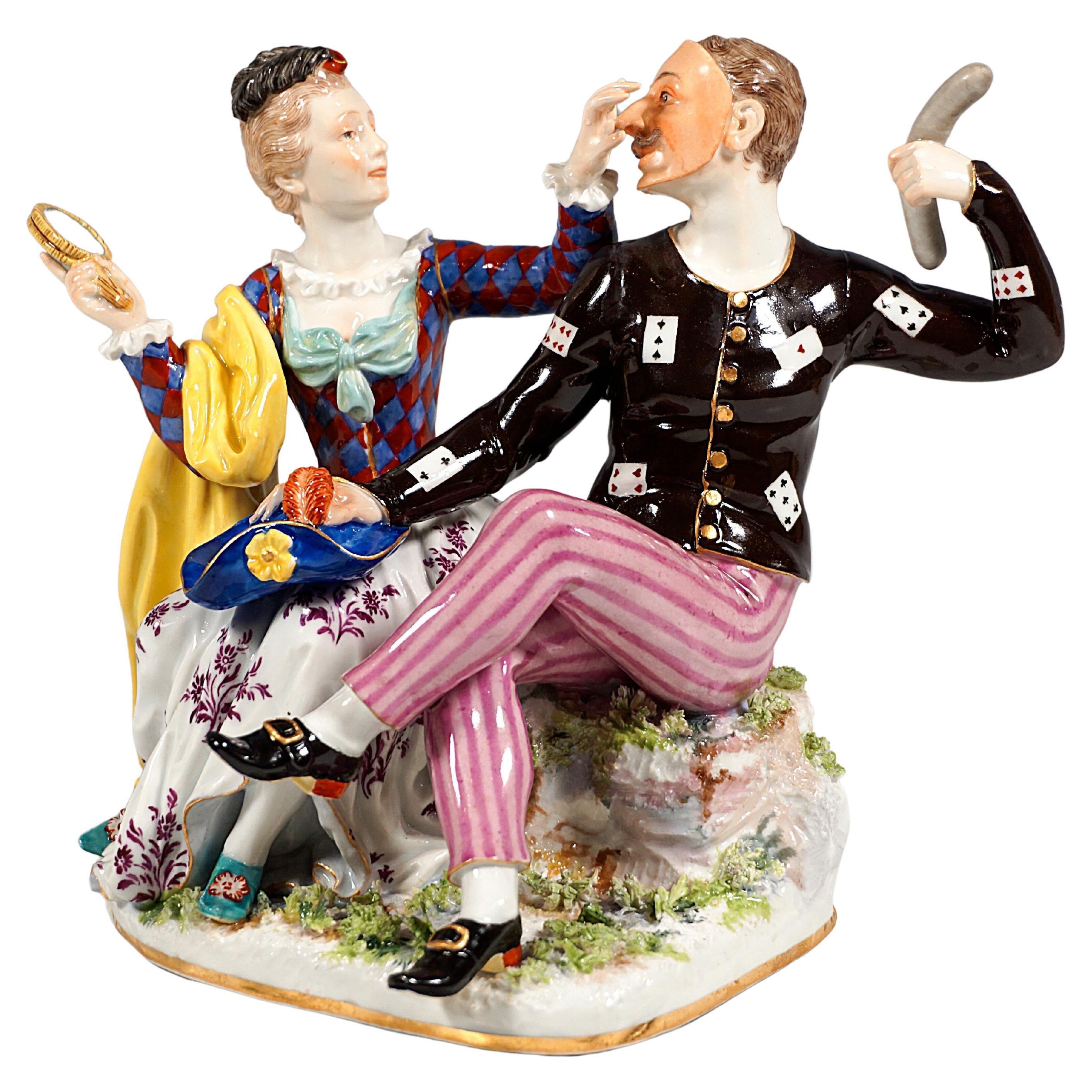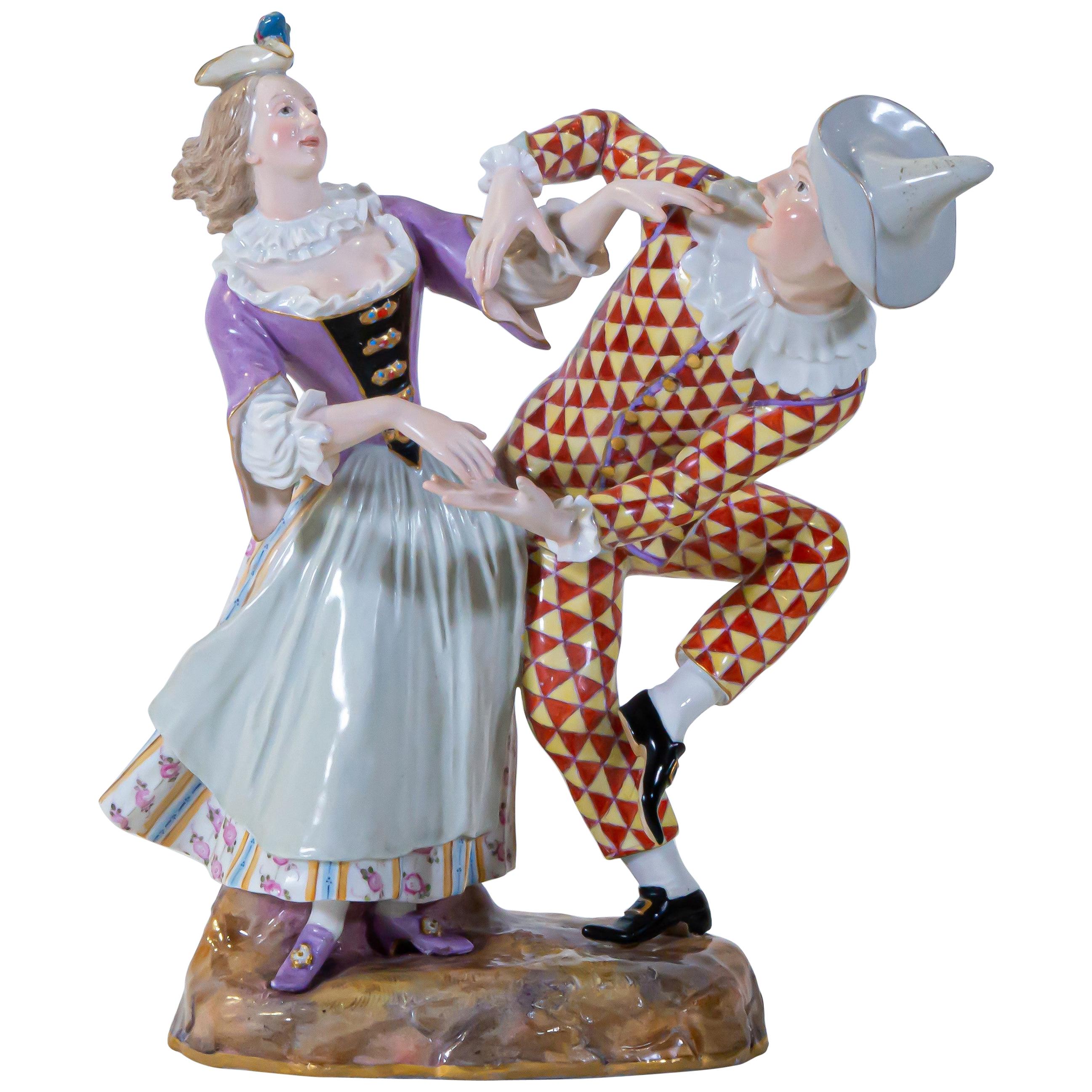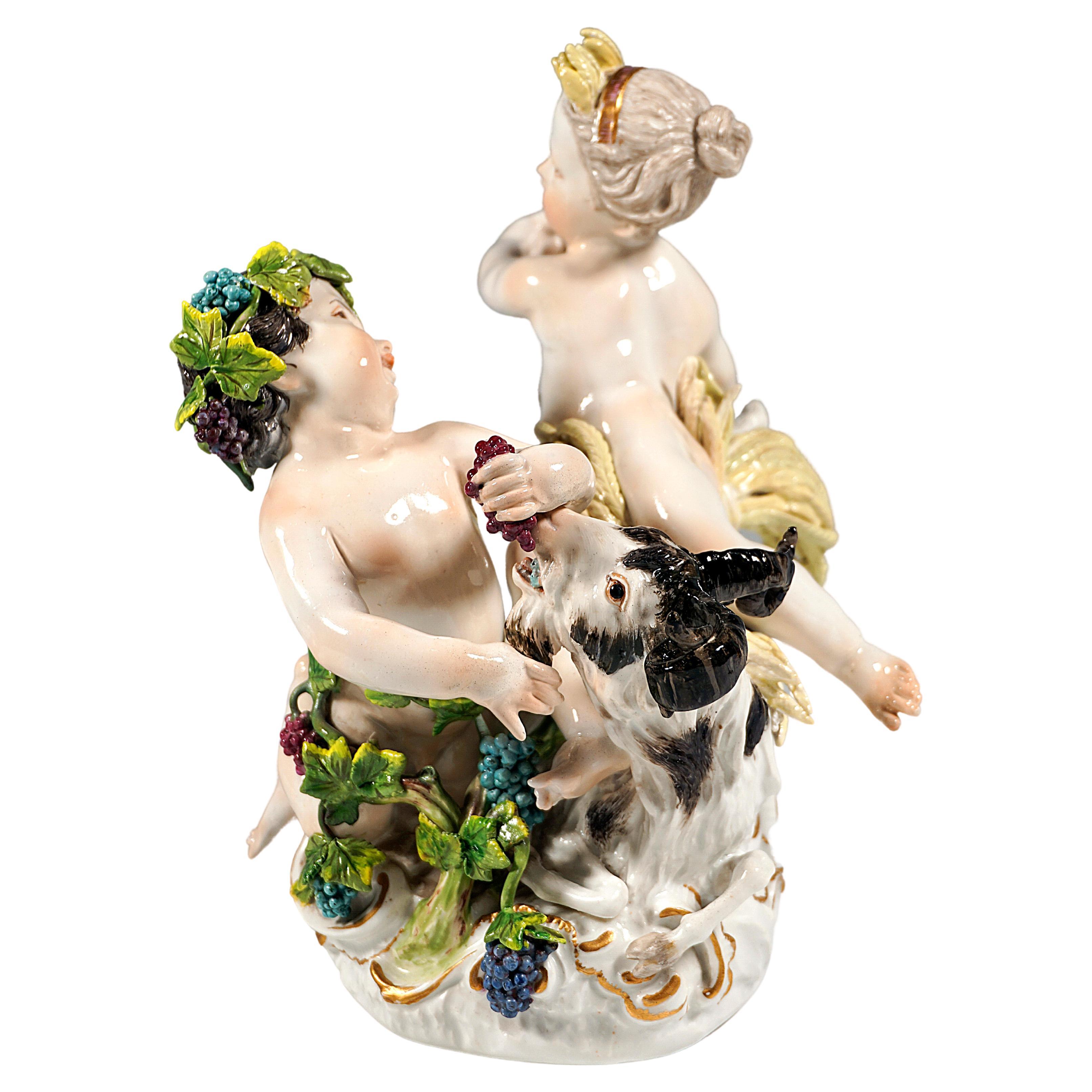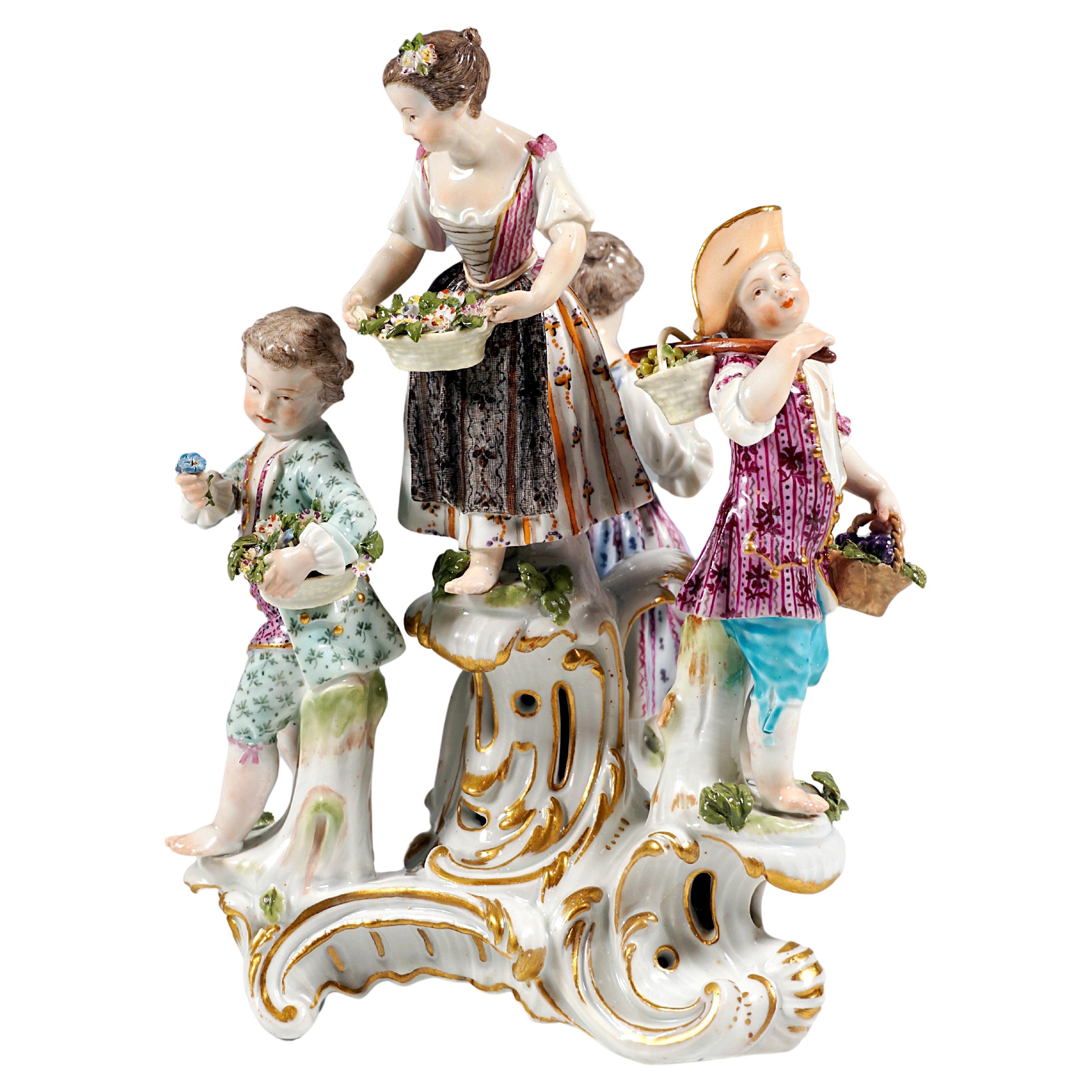Meissen Commedia Dell'Arte Group Harlequin Family by J.J. Kaendler Germany c1870
About the Item
- Creator:Meissen Porcelain (Manufacturer),Johann Joachim Kaendler (Sculptor)
- Dimensions:Height: 6.89 in (17.5 cm)Width: 7.09 in (18 cm)Depth: 4.73 in (12 cm)
- Style:Rococo (In the Style Of)
- Materials and Techniques:
- Place of Origin:
- Period:
- Date of Manufacture:circa 1850
- Condition:
- Seller Location:Vienna, AT
- Reference Number:1stDibs: LU1014433747442
Meissen Porcelain
Meissen Porcelain (Staatliche Porzellan-Manufaktur Meissen) is one of the preeminent porcelain factories in Europe and was the first to produce true porcelain outside of Asia. It was established in 1710 under the auspices of King Augustus II “the Strong” of Saxony-Poland (1670–1733), a keen collector of Asian ceramics, particularly Ming porcelain.
In pursuing his passion, which he termed his “maladie de porcelaine,” Augustus spent vast sums, amassing some 20,000 pieces of Japanese and Chinese ceramics. These, along with examples of early Meissen, comprise the Porzellansammlung, or porcelain collection, of the Zwinger Palace, in Dresden.
The king was determined, however, to free the European market from its dependence on Asian imports and to give European artisans the freedom to create their own porcelain designs. To this end, he charged the scientist Ehrenfried Walther von Tschirnhaus and aspiring alchemist Johann Friedrich Böttger with the task of using local materials to produce true, hard-paste porcelain (as opposed to the soft-paste variety European ceramists in the Netherlands, Germany, France, Italy and Spain had been producing since the late Renaissance). In 1709, the pair succeeded in doing just that, employing kaolin, or “china clay.” A year later, the Meissen factory was born.
In its first decades, Meissen mostly looked to Asian models, producing wares based on Japanese Kakiemon ceramics and pieces with Chinese-inflected decorations called chinoiserie. During the 1720s its painters drew inspiration from the works of Watteau, and the scenes of courtly life, fruits and flowers that adorned fashionable textiles and wallpaper. It was in this period that Meissen introduced its famous cobalt-blue crossed swords logo — derived from the arms of the Elector of Saxony as Arch-Marshal of the Holy Roman Empire — to distinguish its products from those of competing factories that were beginning to spring up around Europe.
By the 1730s, Meissen’s modelers and decorators had mastered the style of Asian ceramics, and Augustus encouraged them to develop a new, original aesthetic. The factory’s director, Count Heinrich von Brühl, used Johann Wilhelm Weinmann’s botanical drawings as the basis for a new line of wares with European-style surface decoration. The Blue Onion pattern (Zwiebelmuster), first produced in 1739, melded Asian and European influences, closely following patterns used in Chinese underglaze-blue porcelain, but replacing exotic flora and fruits with Western varieties (likely peaches and pomegranates, not onions) along with peonies and asters.
During the same period, head modeler Joachim Kändler (1706–75) began crafting delicate porcelain figures derived from the Italian commedia dell’arte. Often used as centerpieces on banquet tables and decorated to reflect the latest fashions in courtly dress for men and women, these figurines were popular in their day, and are still considered among Meissen’s most iconic creations. Kändler also created the Swan Service, which, with its complex low-relief surface design and minimal decoration is considered a masterpiece of Baroque ceramics.
The rise of Neoclassicism in the latter half of the 18th century forced Meissen to change artistic direction and begin producing monumental vases, clocks, chandeliers and candelabra. In the 20th century, Meissen added to its 18th-century repertoire decidedly modern designs, including ones in the Art Nouveau style. The 1920s saw the introduction of numerous animal figures, such as the popular sea otter (Fischotter), which graced an East German postage stamp in the 1960s. Starting in 1933, artistic freedom was limited at the factory under the Nazi regime, and after World War II, when the region became part of East Germany, it struggled to reconcile its elite past with the values of the Communist government. In 1969, however, new artistic director Karl Petermann reintroduced the early designs and fostered a new degree of artistic license. Meissen became one of the few companies to prosper in East Germany.
Owned by the State of Saxony since reunification, in 1990, Meissen continues to produce its classic designs together with new ones developed collaboratively with artists from all over the world. In addition, through its artCAMPUS program, the factory has invited distinguished ceramic artists, such as Chris Antemann and Arlene Shechet, to work in its studios in collaboration with its skilled modelers and painters. The resulting works of contemporary sculpture are inspired by Meissen’s rich and complex legacy.
Find a collection of authentic Meissen Porcelain on 1stDibs.
- ShippingRetrieving quote...Ships From: Vienna, Austria
- Return PolicyA return for this item may be initiated within 7 days of delivery.
- Meissen Commedia Dell' Arte Group 'Harlequin & Columbina', by Kaendler, ca 1860By Meissen Porcelain, Johann Joachim KaendlerLocated in Vienna, ATVery rare 19th century Meissen porcelain group: Harlequin and Columbine seated side by side on a rock and teasing each other: Harlequin in brown playing card patterned jacket, pink striped trousers, black buckled shoes and mask fully covering his face, his left leg crossed over his right and his right hand with blue hat on Columbine's knee holding a sausage in his left raised hand, Columbine reaching for the mask with her left hand, raising a hand mirror with her right. The young woman is wearing a small feather hat, a fitted jacket with a red and blue diamond pattern, a long white skirt...Category
Antique 1860s German Rococo Porcelain
MaterialsPorcelain
- Meissen Mythological Group 'Thalia With Tree', by J.J. Kaendler, Germany, c 1900By Meissen Porcelain, Johann Joachim KaendlerLocated in Vienna, ATVery rare Meissen group: Thalia, the muse of theater and comic poetry, covered only with a large cloth, smiling and sitting on a rock under a cherry tree, holding a mask next to her...Category
Antique Early 1900s German Rococo Porcelain
MaterialsPorcelain
- Meissen Dog Group Pug with Puppy and Bells by J.J. Kaendler Germany, circa 1850By Meissen Porcelain, Johann Joachim KaendlerLocated in Vienna, ATLovingly designed group of animals: Sitting female pug with jingle collar, looking attentively to the right, between her legs a small puppy looking out. Designer: Johann Joachim...Category
Antique 1850s German Rococo Porcelain
MaterialsPorcelain
- Early Meissen Cherub Group Allegory Summer & Autumn, by J.J. Kaendler, C 1750By Meissen Porcelain, Johann Joachim KaendlerLocated in Vienna, ATMeissen Porcelain Group From The Time Of Origin: Two naked cupids and a ram on a rocaille rock, depicting the seasons of summer and autumn: Summer bedded on a bundle of ears of cor...Category
Antique 1760s German Rococo Porcelain
MaterialsPorcelain
- Early Meissen Round Group of Gardener Children, by J.J. Kaendler, 1763-1774By Johann Joachim Kaendler, Meissen PorcelainLocated in Vienna, ATMeissen porcelain group from the time of origin: Four children in festive, rural rococo clothing on a three-part rocaille base: on the central raised pedestal a girl with a basket o...Category
Antique 1760s German Rococo Porcelain
MaterialsPorcelain
- Meissen Group Allegory 'the Love', by J.J. Kaendler, Germany, circa 1900By Johann Joachim Kaendler, Meissen PorcelainLocated in Vienna, ATVery rare and exceptional porcelain figure group: Standing young beauty with her hair tied back at the nape of her neck and crowned with a tiara, wearing a long dress softly embraci...Category
Antique Early 1900s German Rococo Centerpieces
MaterialsPorcelain
- Antique Meissen Group of Commedia Dell"arte, Harlequin and Columbine DancingBy Meissen PorcelainLocated in New York, NYA 19th century Meissen Porcelain Group of Commedia Dell"arte, harlequin and columbine dancing. This example depicts Harlequin dancing...Category
Antique 1850s German Rococo Figurative Sculptures
MaterialsPorcelain
- 18th Century Meissen Commedia Dell'arte Porcelain Figurine by J. J. KandlerBy Meissen PorcelainLocated in New York, NYA 18th century Meissen Commedia Dell'arte porcelain figurine by J. J. Kandler. This exquisitely painted porcelain figurine is a member of the Italian ...Category
Antique 18th Century German Rococo Sculptures
MaterialsPorcelain
- Doctor, from the Commedia Dell'arte, Bow Porcelain, circa 1752By Bow PorcelainLocated in Melbourne, VictoriaIl Dottore from the Commedia dell’Arte, in the white. He stands in an histrionic pose against a tree stump and wears a high brimmed hat (presumably a black academic bonnet), long-buttoned coat over frilled cuffs, falling jabeaux, breeches, boots and a cloak; his right hand on hip, his left arm and hand raised. Slightly grey-white porcelain; even, unctuous glaze. Straw translucency. Underside wiped; air hole at centre. Square hole at rear for mount. Measure: H 6.3 in (16 cm). Provenance: Taylor Collection, from Stockspring Antiques, London, 1998. The Miss G...Category
Antique Late 18th Century English Neoclassical Figurative Sculptures
MaterialsPorcelain
- Figure 'Scapino, ' from the Commedia Dell'arte, Bow Porcelain, circa 1751By Bow PorcelainLocated in Melbourne, VictoriaScappino, or Scapin, a zany (zanni) character from the commedia dell'arte: a buffoon, schemer and scoundrel, and the title character in Molière's Les Fourberies de Scapin, first staged in 1671. The Bow figure shows him standing to right against a tree stump, right leg forward; right arm concealed in a tabarro (cape), and a mask in his left hand. He wears a white doublet, gilt frogged in the Hungarian manner, neck ruff, pale yellow-washed breeches above buckled shoes; a pouch on a red-brown strap and a dagger in a scabbard at the waist. Low square plinth base washed in typical pale Bow ‘lettuce’ green. No discernible translucency. H. 5.0 in (12.6 cm). Provenance: Taylor Collection; Simon Spero London, 2008; the Faith and Dewayne Perry Collection. The Scapino figure was presumably based on the Meissen modelled 1743-45 by Peter Reinicke, assisted by Käendler, and from the series produced for Johann Adlf II, Duke of Weissenfels, after an engraving by Francois Joullain (1662-1753) for Riccobin’s Historie du Théatre Italien, 1728. The modelling and features of the Bow figure suggest the work of the ‘Muses Modeller’, and the pallete, gilding and detail are also those of the muses modeller figures. This figure illustrated Bradshaw, 1992, as circa 1753, Plate 10 (A12), p.64. Scapino is depicted musically in William...Category
Antique Mid-18th Century English Neoclassical Figurative Sculptures
MaterialsPorcelain
- Pair Italian Sculptures Commedia dell'arteLocated in New York, NYRare, Fun and Whimsical is this pair of Commedia dell'arte metal sculptures from Italy circa 1950's. To the eye, these are quite unique and commanding in presence. One is a masked gu...Category
Vintage 1950s Italian Figurative Sculptures
MaterialsMetal
- Antique German porcelain group of Venus with Cupid by MeissenBy Meissen PorcelainLocated in London, GBAntique German porcelain group of Venus with Cupid by Meissen German, c. 1750 Height 20.5cm, width 11cm, depth 12cm This charming Meissen porce...Category
Antique Mid-18th Century German Rococo Figurative Sculptures
MaterialsPorcelain






